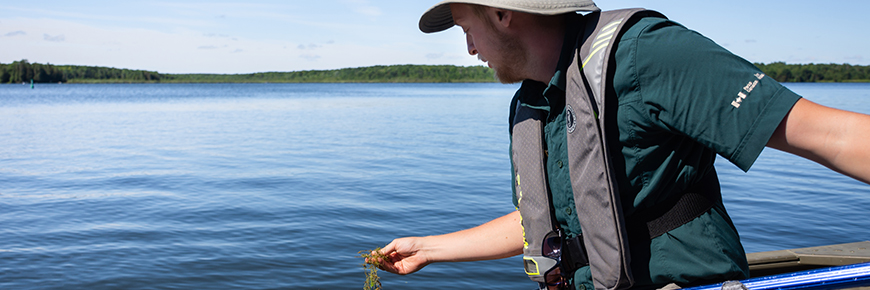
Managing aquatic vegetation on the Trent-Severn Waterway
Trent-Severn Waterway National Historic Site
What is this vegetation?
Aquatic plants in the waters of the Trent-Severn Waterway are an important part of a natural aquatic ecosystem, especially in the ecology of shoreline areas. They provide habitat for fish to spawn, feed and hide from predators. Aquatic plants also play a key role in maintaining and improving the water quality of the Trent-Severn Waterway.
Excessive plant growth can interfere with boating, swimming and other recreational water activities, and at times, some control may be necessary.
What can I do?
A significant contributor to excessive aquatic plant growth is the addition of nutrients to waters of the Trent-Severn Waterway through activities such as fertilizing and the 'hardening' of shorelines. Landowners within the Trent-Severn Waterway watersheds can play a significant role in reducing excessive aquatic plant growth by controlling these activities.
Removing vegetation
If you wish to remove aquatic plants from your property you will require a permit from Parks Canada.
The role of Parks Canada
Parks Canada continues to contribute to aquatic plant research and monitoring along the Trent-Severn Waterway. Scientific knowledge of plant growth trends is a great help in developing more efficient vegetation management programs.
Parks Canada advises waterfront residents on best practices that will help to manage aquatic plant growth.
Parks Canada issues permits for aquatic plant removal. A permit is required prior to any removal of aquatic vegetation.
What you can do
Everyone living within the Trent-Severn Waterway watersheds can play a large role in controlling the growth of aquatic plants. The run-off of nutrients into the waters is the single greatest contributing factor to excessive plant growth.
How you can help to control this:
- Leave (or replant) a minimum three metre buffer of natural vegetation along the shoreline to absorb nutrients before they hit the water.
- Do not use garden chemicals.
- Implementing a rural best management program to reduce nutrient/bacteria runoff from agricultural lands.
- Maintain your septic system in good running order (regular pump-outs and maintain the leaching bed/system).
- Do not “harden” (i.e. pavement, gravel) any near shoreline areas. This increases direct runoff which degrades water quality.
- Encourage the upgrade of municipal sewage systems and stormwater retention.
If you wish to remove aquatic vegetation from the Trent-Severn Waterway, you will require a permit from Parks Canada.
The permit process
Should a waterfront owner wish to remove aquatic vegetation from in front of their property, a permit from Parks Canada is required. This permit is valid for five (5) year and may be obtained by contacting the Trent-Severn Waterway Office of Parks Canada.
Listed below are some conditions of the permit:
- The contractor/landowner is to make all reasonable attempts to harvest and remove the cut aquatic vegetation from the water, and place it upland well above the high water mark.
- In general, no work will be permitted between March 15th and June 30th (fish spawning time).
- The area that may be harvested is 50% of the water frontage to a maximum of 10m (30 feet) wide.
- Harvesting may extend to 30m (100 feet) out into the water body measured perpendicularly from the shoreline.
- All harvesting activity will occur during daylight hours.
- All harvested material must be collected and placed a minimum of 15m (45 feet) upland from the upper controlled water level.
- Emergent aquatic vegetation must not be disturbed.
- Logs and rocks on the bed of the lake must not be disturbed.
For more information please contact:
Parks Canada - Trent-Severn Waterway
2155 Ashburnham Drive
Peterborough, Ontario, Canada
K9J 6Z6
Tel: 705-750-4900
Toll Free: 1-888-773-8888
It's the law
The protection of fish habitat is provided for in the federal Fisheries Act. Violations of this law can result in substantial fines and/or the risk of imprisonment.
- Date modified :